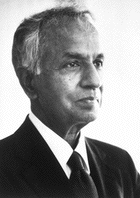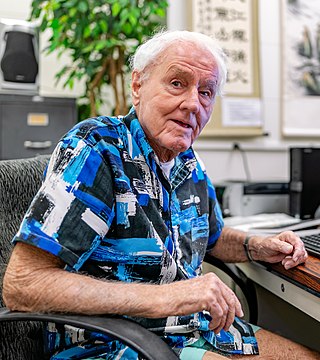Igor Dmitriyevich Novikov is a Russian theoretical astrophysicist and cosmologist.

Sandra Moore Faber is an American astrophysicist known for her research on the evolution of galaxies. She is the University Professor of Astronomy and Astrophysics at the University of California, Santa Cruz, and works at the Lick Observatory. She has made discoveries linking the brightness of galaxies to the speed of stars within them and was the co-discoverer of the Faber–Jackson relation. Faber was also instrumental in designing the Keck telescopes in Hawaii.

Subrahmanyan Chandrasekhar was an Indian-American theoretical physicist who spent his professional life in the United States. He shared the 1983 Nobel Prize for Physics with William A. Fowler for "...theoretical studies of the physical processes of importance to the structure and evolution of the stars". His mathematical treatment of stellar evolution yielded many of the current theoretical models of the later evolutionary stages of massive stars and black holes. Many concepts, institutions, and inventions, including the Chandrasekhar limit and the Chandra X-Ray Observatory, are named after him.

Lyman Spitzer Jr. was an American theoretical physicist, astronomer and mountaineer. As a scientist, he carried out research into star formation, plasma physics, and in 1946, conceived the idea of telescopes operating in outer space. Spitzer invented the stellarator plasma device and is the namesake of NASA's Spitzer Space Telescope. As a mountaineer, he made the first ascent of Mount Thor, with Donald C. Morton.
Horace Welcome Babcock was an American astronomer. He was the son of Harold D. Babcock.
Martin Schwarzschild was a German-American astrophysicist.

Geoffrey Ronald Burbidge (24 September 1925 – 26 January 2010) was an English astronomy professor and theoretical astrophysicist, most recently at the University of California, San Diego. He was married to astrophysicist Margaret Burbidge and was the second author of the influential B2FH paper which she led.
William Wilson Morgan was an American astronomer and astrophysicist. The principal theme in Morgan's work was stellar and galaxy classification. He is also known for helping prove the existence of spiral arms in our galaxy. In addition to his scientific achievements he served as a professor and as astronomy director for University of Chicago, and was the managing editor for George Hale's Astrophysical Journal.

Henrietta Hill Swope was an American astronomer who studied variable stars. In particular, she measured the period-luminosity relation for Cepheid stars, which are bright variable stars whose periods of variability relate directly to their intrinsic luminosities. Their measured periods can therefore be related to their distances and used to measure the size of the Milky Way and distances to other galaxies.

Frank Kelley Edmondson was an American astronomer.
George Whipple Clark was an American astronomer and professor emeritus at the Massachusetts Institute of Technology. When he retired, M.I.T. described him as "a central figure in the development of high-energy astrophysics, particularly in the design, analysis, and interpretation of experiments for the study of high-energy cosmic ray particles and the celestial sources of gamma rays and X-rays."

Margaret J. Geller is an American astrophysicist at the Center for Astrophysics | Harvard & Smithsonian. Her work has included pioneering maps of the nearby universe, studies of the relationship between galaxies and their environment, and the development and application of methods for measuring the distribution of matter in the universe.

Alexander Dalgarno FRS was a British physicist who was a Phillips Professor of Astronomy at Harvard University.

Arthur Dodd Code was an astronomer who designed orbiting observatories.
Theodore Dunham Jr. was an American astronomer and physicist.

Helmut Arthur Abt is a German-born American astrophysicist, having worked at the National Optical Astronomy Observatory and an Elected Fellow of the American Association for the Advancement of Science. He is astronomer emeritus at Kitt Peak National Observatory.
Sheperd "Shep" S. Doeleman is an American astrophysicist. His research focuses on super massive black holes with sufficient resolution to directly observe the event horizon. He is a senior research fellow at the Center for Astrophysics | Harvard & Smithsonian and the Founding Director of the Event Horizon Telescope (EHT) project. He led the international team of researchers that produced the first directly observed image of a black hole.

Andrea Dupree is a senior astrophysicist at the Center for Astrophysics | Harvard & Smithsonian. She is a Past-President of the American Astronomical Society, and served as the associate director of the Center for Astrophysics | Harvard & Smithsonian. Dupree also served as Head of the Solar, Stellar and Planetary Sciences Division.
William Frank Brinkman is an American physicist who served as president of the American Physical Society (2002) and was the head of the Office of Science at the United States Department of Energy (2009–2013). He was elected to the National Academy of Sciences in 1984, and won the George E. Pake Prize in 1994. He was elected as a member of the American Academy of Arts and Sciences in 1992, and became a member of the American Philosophical Society in 2002.
Herbert Friedman was an American physicist and astronomer who did research in X-ray astronomy. During his career Friedman published hundreds of scientific papers. One such example is "Ultraviolet and X Rays from the Sun". He was elected to the American Academy of Arts and Sciences and the United States National Academy of Sciences in 1960. He received the Eddington Medal of the Royal Astronomical Society in 1964. That same year, he was elected to the American Philosophical Society.











